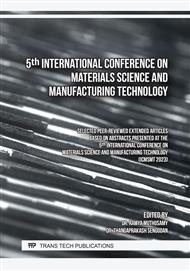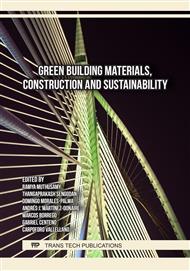[1]
Y. Yardim and O. Lalaj, "Shear strengthening of unreinforced masonry wall with different fiber reinforced mortar jacketing," Constr. Build. Mater., vol. 102, p.149–154, 2016.
DOI: 10.1016/j.conbuildmat.2015.10.095
Google Scholar
[2]
O. V. Kabantsev, "Modeling Nonlinear Deformation and Destruction Masonry under Biaxial Stresses Part 1 – Masonry as Simulation Object," Appl. Mech. Mater., vol. 725–726, p.681–696, 2015.
DOI: 10.4028/www.scientific.net/amm.725-726.681
Google Scholar
[3]
O. Kabantsev and D. Cajamarca-Zuniga, "Improvement of the brick to increase the tangential bond strength of the masonry," Mater. Today Proc., no. (iCATCHCOME 2023), p.8, 2023.
DOI: 10.1016/j.matpr.2023.05.640
Google Scholar
[4]
S. Sahu, P. R. R. Teja, P. Sarkar, and R. Davis, "Effect of Brick Prewetting on Masonry Bond Strength," J. Mater. Civ. Eng., vol. 31, no. 10, p.1–9, 2019.
DOI: 10.1061/(asce)mt.1943-5533.0002866
Google Scholar
[5]
S. Anandan and M. Alsubih, "Mechanical strength characterization of plastic fiber reinforced cement concrete composites," Appl. Sci., vol. 11, no. 2, p.1–21, 2021.
DOI: 10.3390/app11020852
Google Scholar
[6]
M. R. Latifi, Ö. Biricik, and A. Mardani Aghabaglou, "Effect of the addition of polypropylene fiber on concrete properties," J. Adhes. Sci. Technol., vol. 36, no. 4, p.345–369, 2022.
DOI: 10.1080/01694243.2021.1922221
Google Scholar
[7]
P. N. Gajjar, E. Gabrielli, D. C. Martin-alarcon, P. B. Lourenço, and C. Colla, "An experimental and numerical contribution for understanding the in-situ shear behaviour of unreinforced masonry," J. Build. Eng., vol. 44, no. 103389, p.15, 2021.
DOI: 10.1016/j.jobe.2021.103389
Google Scholar
[8]
A. M. Halabian, L. Mirshahzadeh, and H. Hashemol-Hosseini, "Non-linear behavior of unreinforced masonry walls with different Iranian traditional brick-work settings," Eng. Fail. Anal., vol. 44, p.46–65, 2014.
DOI: 10.1016/j.engfailanal.2014.04.018
Google Scholar
[9]
P. W. Chen and D. D. L. Chung, "A comparative study of concretes reinforced with carbon, polyethylene, and steel fibers and their improvement by latex addition," ACI Mater. J., vol. 93, no. 2, p.129–133, 1996.
DOI: 10.14359/1411
Google Scholar
[10]
K. Goda, P. Kloukinas, I. Kafodya, I. Ngoma, V. Novelli, and J. Macdonald, "Strength of materials and masonry structures in malawi," Adv. Eng. Mater. Struct. Syst. Innov. Mech. Appl. - Proc. 7th Int. Conf. Struct. Eng. Mech. Comput. 2019, no. June 2020, p.1697–1702, 2019.
DOI: 10.1201/9780429426506-293
Google Scholar
[11]
A. Costigan, S. Pavía, and O. Kinnane, "An experimental evaluation of prediction models for the mechanical behavior of unreinforced, lime-mortar masonry under compression," J. Build. Eng., vol. 4, p.283–294, 2015.
DOI: 10.1016/j.jobe.2015.10.001
Google Scholar
[12]
N. Almesfer, D. Y. Dizhur, R. Lumantarna, and J. M. Ingham, "Material properties of existing unreinforced clay brick masonry buildings in New Zealand," Bull. New Zeal. Soc. Earthq. Eng., vol. 47, no. 2, p.75–96, 2014.
DOI: 10.5459/bnzsee.47.2.75-96
Google Scholar
[13]
S. Petry and K. Beyer, "Cyclic test data of six unreinforced masonry walls with different boundary conditions," Earthq. Spectra, vol. 31, no. 4, p.2459–2484, 2015.
DOI: 10.1193/101513EQS269
Google Scholar
[14]
I. Khan, M. Ashraf, and M. Fahim, "Experimental characterization of brick masonry for lateral strength evaluation," Mag. Civ. Eng., vol. 104, no. 4, 2021.
Google Scholar
[15]
J. A. Dauda, O. Iuorio, and P. B. Lourenço, "Numerical analysis and experimental characterisation of brick masonry," Int. J. Mason. Res. Innov., vol. 5, no. 3, p.321–347, 2020.
DOI: 10.1504/IJMRI.2020.107994
Google Scholar
[16]
N. Savalle, P. B. Lourenço, and G. Milani, "Joint Stiffness Influence on the First-Order Seismic Capacity of Dry-Joint Masonry Structures: Numerical DEM Investigations," Appl. Sci., vol. 12, no. 4, p.2108, 2022.
DOI: 10.3390/app12042108
Google Scholar
[17]
M. Del Zoppo, M. Di Ludovico, A. Balsamo, and A. Prota, "Diagonal compression testing of masonry panels with irregular texture strengthened with inorganic composites," Mater. Struct. Constr., vol. 53, no. 4, p.1–17, 2020.
DOI: 10.1617/s11527-020-01539-z
Google Scholar
[18]
R. Sousa, H. Sousa, and J. Guedes, "Diagonal compressive strength of masonry samples - Experimental and numerical approach," Mater. Struct. Constr., vol. 46, no. 5, p.765–786, 2013.
DOI: 10.1617/s11527-012-9933-z
Google Scholar
[19]
N. Mojsilović, "Masonry subjected to semi-cyclic compression: Inelastic response modelling," Constr. Build. Mater., vol. 263, 2020.
DOI: 10.1016/j.conbuildmat.2020.120147
Google Scholar
[20]
A. Abdullah, S. B. Jamaludin, M. M. Noor, and K. Hussin, "Composite cement reinforced coconut fiber: Physical and mechanical properties and fracture behavior," Aust. J. Basic Appl. Sci., vol. 5, no. 7, p.1228–1240, 2011.
Google Scholar
[21]
G. Araya-Letelier, P. Maturana, M. Carrasco, F. C. Antico, and M. S. Gómez, "Mechanical-damage behavior of mortars reinforced with recycled polypropylene fibers," Sustain., vol. 11, no. 8, 2019.
DOI: 10.3390/su11082200
Google Scholar
[22]
C. Higuera Flórez, J. Cárdenas-Pulido, and S. Rodríguez, "Evaluación del comportamiento a compresión y propiedades físicas de morteros de cemento reforzados con fibras recicladas PET," Sci. Tech., vol. 25, no. 2, p.269–279, 2020.
DOI: 10.22517/23447214.23771
Google Scholar
[23]
R. Tuladhar and S. Yin, Sustainability of using recycled plastic fiber in concrete. Elsevier Ltd, 2019.
Google Scholar
[24]
INEC, "Información Ambiental en Hogares ESPND 2018," Inst. Nac. Estad. y Censo, p.36, 2021.
Google Scholar
[25]
Danilo Gomes de Arruda, "Programa Nacional para la Gestión Integral de Desechos Sólidos (PNGIDS)," p.6, 2021.
Google Scholar
[26]
L. O. G. Vaca, "DISEÑO Y CONSTRUCCIÓN DE UN PROTOTIPO DE PROCESADORA DE BOTELLAS PLÁSTICAS PET RECICLADAS PARA LA OBTENCIÓN DE FIBRA DE POLIÉSTER." 2021.
DOI: 10.33262/concienciadigital.v4i1.2.1585
Google Scholar
[27]
J. P. Ojeda, I. T. Mercante, and N. H. Fajardo, "Design and test of recycled plastic fibers for mortar reinforcement," Rev. Int. Contam. Ambient., vol. 36, no. 1, p.55–62, 2020.
DOI: 10.20937/RICA.2020.36.53423
Google Scholar
[28]
I. E. de Normalización NTE INEN 2518:2010, "Morteros para Unidades de Mampostería." 2010.
Google Scholar
[29]
NEC-SE-MP, Norma Ecuatoriana de la Construcción. Mampostería Estructural. Ecuador: Ministerio de Desarrollo Urbano y Vivienda, 2015.
Google Scholar
[30]
I. N. de Normalización INN Chile, "Building construction - Ceramic bricks - Tests methods," Norma Chil. Of. NCh 167.Of2001, 2001.
Google Scholar
[31]
EN 1052-3-2002, Methods of test for masonry - Part 3 - Shear Strength. European Union: European Committee for Standarization, 2007.
Google Scholar
[32]
S. V. Polyakov, Bonding in Brickwork. Moscow: Gos Stroyizdat, 1959.
Google Scholar



